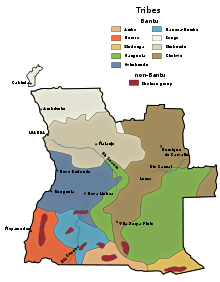Bailundo Revolt of 1902
| Bailundo Revolt of 1902 | |||||||
|---|---|---|---|---|---|---|---|

Ovimbundu area
within modern day Angola
|
|||||||
|
|||||||
| Belligerents | |||||||
|
|
Kisanji Luimbi |
||||||
| Commanders and leaders | |||||||
|
|
Kalandula (POW) Mutu ya Kevela † Samakaka Livongue † Civava † |
||||||
| Strength | |||||||
| 750 troops 1,000 Auxiliaries |
10,000 | ||||||
| Casualties and losses | |||||||
| Minimal | +2,000 casualties | ||||||
| +120 civilians | |||||||
The Bailundo Revolt was an insurrection launched by the Ovimbundu kingdom of Bailundo and its allies against the Portuguese Empire. The revolt was prompted by the sudden decline of the price of root rubber, pitting the indigenous population against European immigrants and aboriginal loyalists. The revolt lasted between 1902 - 1904, ending in a Portuguese victory.
The fertile Benguela highlands also known as Nano were traditionally settled by other Bantu people. The early 17th century invasion of the Imbangala tribesmen led to a merger of the two populations and the subsequent creation of the Ovimbundu kingdoms. The Benguela region was first explored by Portuguese merchants in middle of the 17th century, initiating the trade of slaves, ivory, beeswax and rubber. Occasional clashes between the Portuguese and Ovimbudu occurred in the 18th and 19th century, taking place in the two major regional trading arteries of Benguela - Caconda Nova and Catumbella - Northern Huambo. Private armies belonging to merchants and tribal chiefs fought each other over the control of the southern trading route. Following the defeat of the Bailundo and Bié in the 1774 war against the Portuguese, the two kingdoms remained at peace sharing control over the northern trading route.
In the middle of the 19th century, Portuguese colonists began building forts in Ovimbundu controlled areas. Despite the fact, power largely remained in the hands of local kings and powerful merchants. Trading continued to flourish, as army deserters, Portuguese convicts, vagrants, mulattoes and locals became engaged in the long distance caravan trade.
By the beginning of the 20th, the Benguela region was controlled by 22 Ovimbundu kingdoms, the Bailundo, Bié and Huambo being the most powerful of them. The 1874 invention of root rubber, quickly established it as a substitute good for traditional rubber. Bailundo citizens became increasingly involved in the peaking rubber trade between the period of 1886-1901, abandoning traditional raiding activities.
In 1890, a Portuguese punitive expedition overthrew the king of the Bié kingdom turning it into a puppet state, while accelerating the settlement of Portuguese and Boer settlers and reinforcing the area's garrison. The fall of Bié in combination with the shift in allegiance of a number of smaller puppet kingdoms separating Bailundo from areas under Portuguese control brought Bailundo into the Portuguese sphere of interest. However the Portuguese administrative control of the area remained weak, the colonial authorities were only represented by a small number of low level officials and soldiers. Portugal's lack of coherent political control in the region lead to the rise of anti colonial attitudes. In 1902, the artificially high price of rubber suddenly plummeted due to the immoderate credit practices, causing an economic depression. Immediately before the rebellion, the Ovimbundu were hit by a smallpox epidemic and a famine.
...
Wikipedia
